FIND MISSING ANGLES IN ISOCELES TRAPEZIUM
Subscribe to our ▶️ YouTube channel 🔴 for the latest videos, updates, and tips.
What is Trapezium ?
A trapezium is a convex quadrilateral with exactly one pair of opposite sides parallel to each other. The trapezium is a two-dimensional are called legs. It is also called a trapezoid. Sometimes the parallelogram is also called a trapezoid with two parallel sides.
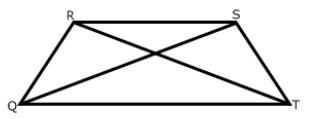
Properties :
(i) All the properties of a trapezoid
(ii) Non-parallel sides are congruent.
(iii) Diagonals are congruent.
(iv) Base angles are congruent.
(v) Opposite angles are supplementary
Find the measurement of the angle indicated for each trapezoid.
Problem 1 :
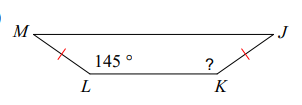
Solution :
∠MLK = 145°
Since the base angles are equal,
∠JKL = 145°
Problem 2 :
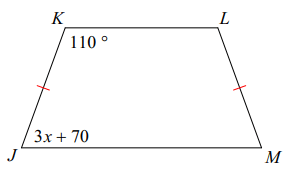
Solution :
The trapezium will have two parallel sides and two non parallel sides.
∠LKJ + ∠KJM = 180 (Co-interior angles)
110 + 3x + 70 = 180
180 + 3x = 180
3x = 180 - 180
3x = 0
x = 0/3
x = 0
Problem 3 :
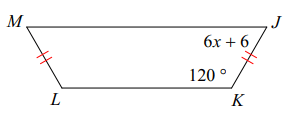
Solution :
The trapezium will have two parallel sides and two non parallel sides.
∠MJK + ∠JKL = 180 (Co-interior angles)
6x + 6 + 120 = 180
6x + 126 = 180
Subtracting 126 on both sides.
6x = 180 - 126
6x = 54
Divide by 6 on both sides
x = 54/6
x = 9
Problem 4 :
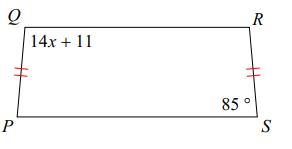
Solution :
Opposite angles are supplementary.
14x + 11 + 85 = 180
14x + 96 = 180
14x = 180 - 96
14x = 84
Dividing by 14 on both sides.
x = 84/14
x = 6
Problem 5 :
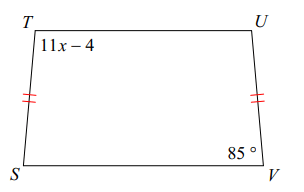
Solution :
Opposite angels are supplementary.
11x - 4 + 85 = 180
11x + 81 = 180
Subtracting 81, we get
11x = 180 - 81
11x = 99
Dividing by 11, we get
x = 99/11
x = 9
Problem 6 :
Given isosceles trapezoid 𝐴𝐵𝐶𝐷, 𝐵𝐶 ∥ 𝐴𝐷. If 𝑚 < 𝐴 = 3(2x − 7) and 𝑚 < 𝐶 = 4x + 1, find the value of x. Find the measure of all of the angles.
Solution :
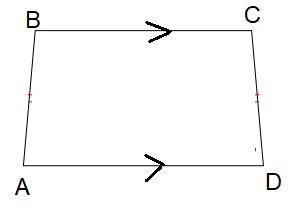
𝑚 ∠𝐴 = 3(2x − 7) and 𝑚 ∠𝐶 = 4x + 1
From the picture above, angle A and C are base angles and they are equal.
3(2x - 7) = 4x + 1
6x - 21 = 4x + 1
Subtracting 4x on both sides,
6x - 4x = 1 + 21
2x = 22
Dividing by 2 on both sides
x = 22/2
x = 11
Problem 7 :
Find ∠V
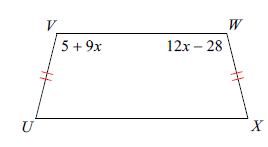
Solution :
Adjacent angels between parallel sides and one non parallel side add upto 180 degree.
5 + 9x = 12x - 28
Subtracting 12x and subtracting 5 on both sides.
9x - 12x = -28 - 5
-3x = -33
x = 33/3
x = 11
Angel V :
∠V = 5 + 9x
∠V = 5 + 9(11)
∠V = 5 + 99
∠V = 104
Problem 8 :
Find ∠M
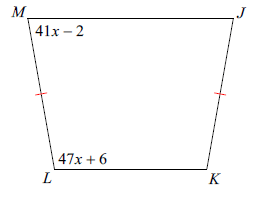
Solution :
Sum of co interior angles = 180
41x - 2 + 47x + 6 = 180
41x + 47x + 4 = 180
88x + 4 = 180
Subtracting 4 on both sides.
88x = 180 - 4
88x = 176
Dividing by 88, we get
x = 176/88
x = 2
∠M = 41x - 2
= 41(2) - 2
= 82 - 2
∠M = 80
Problem 9 :
Isosceles trapezoid ABCD with BC ||AD. If m∠A = 4x+20 and m∠D = 2x+38, find m∠A, m∠B, m∠C, and m∠D.

Solution :
The base angles are equal
m∠A = 4x+20 and m∠D = 2x+38
m∠A = m∠D
4x + 20 = 2x + 38
4x - 2x = 38 - 20
2x = 18
x = 18/2
x = 9
Problem 10 :
In isosceles trapezoid ABCD, BC||AD. The measure of ∠ADC = 4x+20 and the measure of ∠DAB = 8x - 20. Find the value of x, ∠ADC, ∠DAB, ∠BCD, and ∠ABC.
Solution :
∠ADC = 4x+20 and ∠DAB = 8x - 20.
∠ADC = ∠DAB
4x + 20 = 8x - 20
4x - 8x = - 20 - 20
-4x = -40
x = 40/4
x = 10
|
∠ADC = 4x+20 = 4(10)+20 = 40 + 20 ∠ADC = 60 |
∠DAB = 8x - 20 = 8(10) - 20 = 80 - 20 ∠DAB = 60 |
∠BCD :
∠ADC and ∠BCD are co interior angles.
∠ADC + ∠BCD = 180
60 + ∠BCD = 180
∠BCD = 180 - 60
∠BCD = 120
∠DAB and ∠ABC are co interior angles.
∠DAB + ∠ABC = 180
60 + ∠ABC = 180
∠ABC = 180 - 60
∠ABC = 120
Subscribe to our ▶️ YouTube channel 🔴 for the latest videos, updates, and tips.
Recent Articles
-
Finding Range of Values Inequality Problems
May 21, 24 08:51 PM
Finding Range of Values Inequality Problems -
Solving Two Step Inequality Word Problems
May 21, 24 08:51 AM
Solving Two Step Inequality Word Problems -
Exponential Function Context and Data Modeling
May 20, 24 10:45 PM
Exponential Function Context and Data Modeling